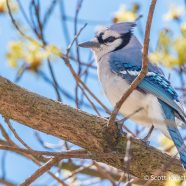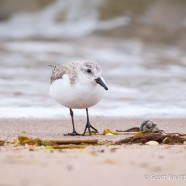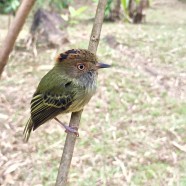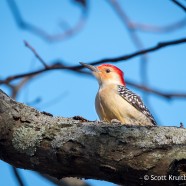Blue Jay
This Blue Jay (Cyanocitta cristata) was in the shade on a sunny April day, nevertheless showing off blue hues against a blue sky and flying around with its mate. In this case the blues are not as blue as they could be because they are not actually blue. Huh? Their feather barb cells are specially modified scatter light in a way that makes them appear blue instead of what would be brown melanin, and if this bird flew into the sunlight then it would pop even more. Scott Kruitbosch Conservation & Outreach Coordinator
Read MoreSanderling
Here we have a Sanderling (Calidris alba), a bird that spends its winter on our sandy beaches before heading to the High Arctic for the nesting season. They are often misidentified as Piping Plovers during migratory periods as both small, white shorebirds (in nonbreeding plumage for the Sanderling anyway) feed along the water like this. A rufous breeding plumage pattern takes over where the gray is, and by May these birds look unique and spectacular. So much change in so little time…and so much flight distance covered before they nest and head back to us later in the summer. If that...
Read MoreScale-crested Pygmy-Tyrant (Lophotriccus pileatus)
RTPI Affiliate Sean Graesser says that his favorite resident bird netted in this past trip to Costa Rica was the Scale-crested Pygmy-Tyrant (Lophotriccus pileatus). It seems that not much is known about this species. They sure are charismatic with a small crest and tenacious attitude to match. This individual bounced around in some vegetation before taking off.
Read MoreRed-bellied Woodpecker
Over the course of Roger Tory Peterson’s lifetime the Red-bellied Woodpecker (Melanerpes carolinus) pushed its typical range much further north, moving into his homes in Jamestown, New York and Old Lyme, Connecticut. This was likely due to a combination of climate change, agricultural areas and grasslands being allowed to mature into woodlands, and humans spreading into suburbs creating additional favorable habitat and feeding birds year-round in their yards. The species can now commonly be found in both of Roger’s favorite locations. This bird is a male, showing his red forehead...
Read MoreBanded Woolly Bear
This Banded Woolly Bear caterpillar (Pyrrharctia isabella) had already gone into defensive mode, balling up after I spotted it and before I returned with my camera. I will say one thing for this individual – I love the look! The old story goes that more extensive black covering the body means it will be a colder and snowier winter will be for us, and the more brown a caterpillar has the warmer it will be. Even though it is not stretched out you can see how much brown we have here, and I like it! I think we could all go for a warmer winter than the last two historically cold seasons. I...
Read More








